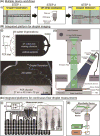Droplet microfluidics for high-sensitivity and high-throughput detection and screening of disease biomarkers
- PMID: 29797414
- PMCID: PMC6185786
- DOI: 10.1002/wnan.1522
Droplet microfluidics for high-sensitivity and high-throughput detection and screening of disease biomarkers
Abstract
Biomarkers are nucleic acids, proteins, single cells, or small molecules in human tissues or biological fluids whose reliable detection can be used to confirm or predict disease and disease states. Sensitive detection of biomarkers is therefore critical in a variety of applications including disease diagnostics, therapeutics, and drug screening. Unfortunately for many diseases, low abundance of biomarkers in human samples and low sample volumes render standard benchtop platforms like 96-well plates ineffective for reliable detection and screening. Discretization of bulk samples into a large number of small volumes (fL-nL) via droplet microfluidic technology offers a promising solution for high-sensitivity and high-throughput detection and screening of biomarkers. Several microfluidic strategies exist for high-throughput biomarker digitization into droplets, and these strategies have been utilized by numerous droplet platforms for nucleic acid, protein, and single-cell detection and screening. While the potential of droplet-based platforms has led to burgeoning interest in droplets, seamless integration of sample preparation technologies and automation of platforms from biological sample to answer remain critical components that can render these platforms useful in the clinical setting in the near future. This article is categorized under: Diagnostic Tools > Biosensing Diagnostic Tools > Diagnostic Nanodevices Therapeutic Approaches and Drug Discovery > Emerging Technologies Therapeutic Approaches and Drug Discovery > Nanomedicine for Infectious Disease.
Keywords: biomarker; clinical; diagnostic; droplet; microfluidics.
© 2018 Wiley Periodicals, Inc.
Figures









References
-
- Anna SL, Bontoux N, Stone HA. Formation of dispersions using “flow focusing” in microchannels. Applied Physics Letters. 2003;82(3):364–366. doi: 10.1063/1.1537519. - DOI
Publication types
MeSH terms
Substances
Grants and funding
LinkOut - more resources
Full Text Sources
Other Literature Sources

